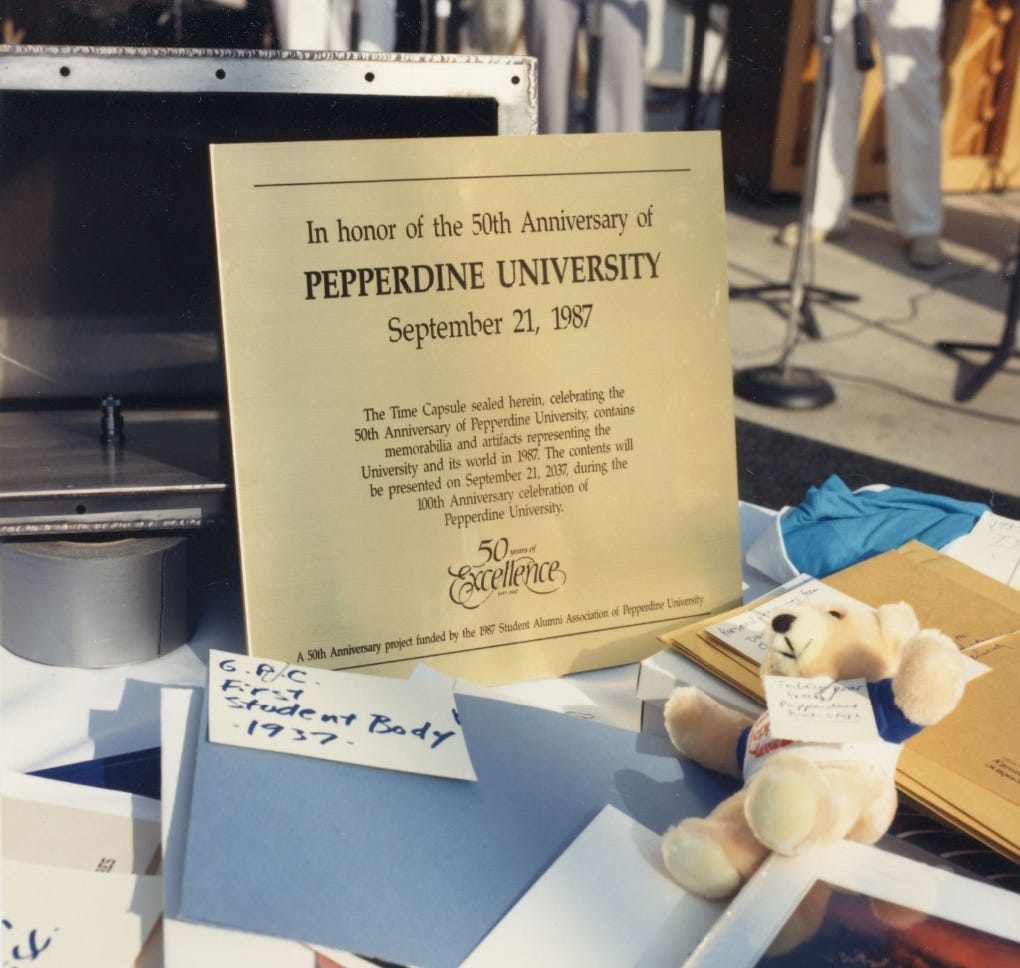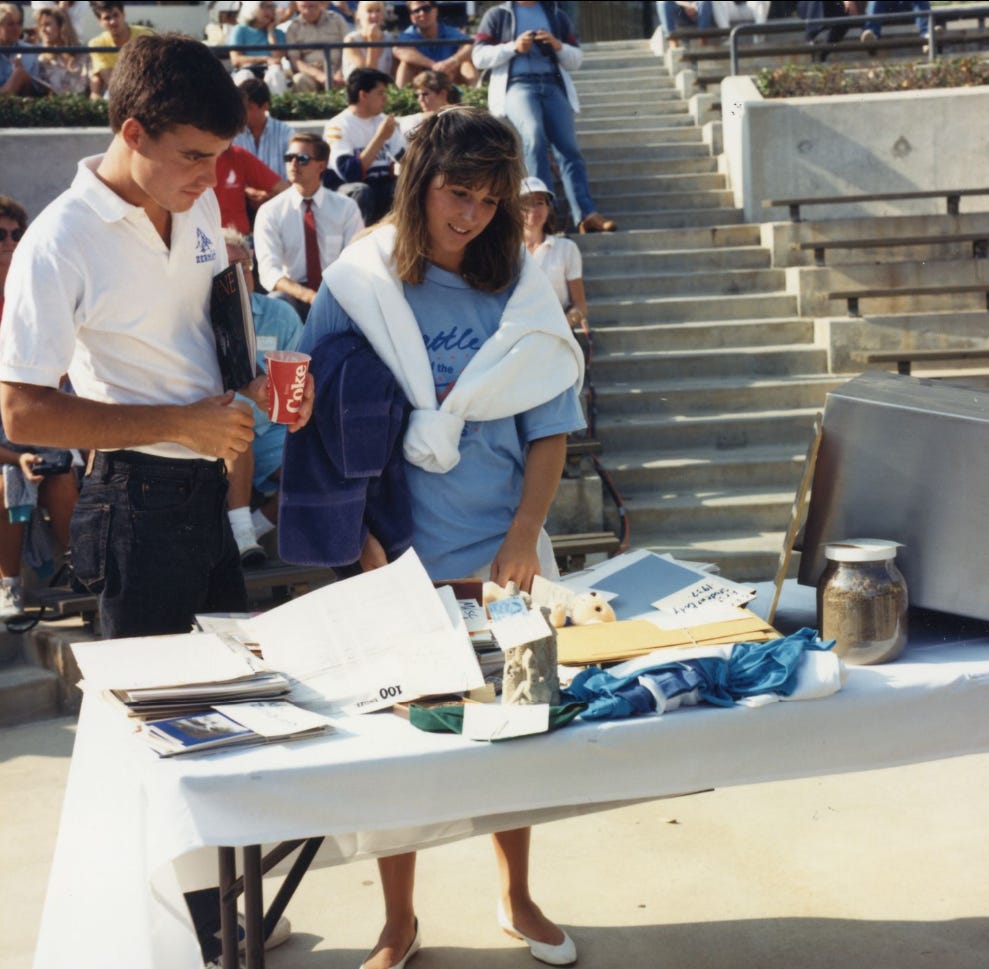In 1987, Pepperdine buried a time capsule in honor of the university’s fiftieth anniversary, scheduling it to be opened at the centennial celebration in 2037. You can still find the plaque in front of the Thornton Administrative Center (TAC), though it’s not as shiny as it was in 1987. But what’s in the time capsule, and what can it tell us about Pepperdine?

Souvenirs of the past
I’m not aware of a surviving list of the capsule’s contents, but we can piece together some of them from pictures and news accounts. Archival photographs show the capsule and its plaque at the fiftieth anniversary celebration in September 1987, along with some of the contents, most of which seems to be paper—books, photos, a list of the first students at George Pepperdine College, personal messages from president David Davenport, chancellor Charles Runnels, et al., etc.
Among the non-paper items are a T-shirt, a teddy bear from the university bookstore, a jar of what looks like sand, and some kind of carved castle souvenir that doesn’t look like Heidelberg Castle to me. There’s also some green fabric that I think must be one of the old green beanies that freshmen were made to wear during orientation at the Vermont Avenue campus.
A Graphic profile of alumnus Colin Matthew Thomas (Seaver ’87) mentions that his undergraduate thesis on chaparral recovery after wildfires was chosen to be included in the time capsule.1 And a university magazine says that a scroll with the names of guests who attended the interment ceremony was included.2

The capsule itself is a metal box (maybe stainless steel) that looks about the same size as a microwave oven, and pictures show a roll of waterproof tape nearby, making me think it was probably used to seal the box. It’s hard to know how well the contents will have survived their fifty years underground, but I think the odds are good that all Malibu’s earthquakes and wildfires haven’t done much damage.
The time capsule is a sign that in 1987 Pepperdine was as interested in its future as its past. Of course, a time capsule is an attempt to communicate a message into the future, but much of what was communicated is about the university’s past. Many embraced the anniversary as a chance to think about the institution’s history. Jerry Rushford put together a book called Crest of a Golden Wave, summarizing the previous fifty years, and president emeritus Howard White gave a lecture on the university’s Christian heritage.3
Hopes for the future
As part of the fiftieth anniversary celebration, the student magazine Oasis asked some Pepperdine bigwigs about their hopes for the university in 2037.4 Some answers show how hard it is to think on a fifty-year timescale. The student body president Alyssa Allen hoped that by 2037 the university would have a student center and would allow dancing on campus—both of which would be achieved within the next eight years.5 Senior vice president Larry Hornbaker hoped for an endowment of $500 million—surpassed in fiscal year 2006 and doubled to a billion in the next fifteen years.6
Some predictions were less optimistic: Allen thought parking would still be a problem on the Malibu campus in 2037, and University Church preacher Dan Anders predicted “the depletion of natural resources and the shrinkage of wealth will change the way we live. A more austere lifestyle will prod us to think deeply about lasting values.”
But the main impression I get from these predictions about 2037 is how important it was to the old-timers that the core of Pepperdine’s identity be successfully transmitted to future generations. Howard White hoped that in 2037 Pepperdine would be known for two things, “Reaching for the highest standards of academic excellence, and maintaining the Christian heritage and value system which has been its foundation during the first 50 years.” And the founder’s widow Helen Pepperdine agreed, recalling his speech at the college’s dedication: “He spoke with conviction that the objectives to be attained were to provide a first class liberal arts college dedicated to an even greater goal of building within students a love for Christ and a passion for the souls of mankind.”
Time machines
A time capsule is just a slow time machine, traveling into the future at the rate of one year per year, and capable of outliving those who sent it. And understood this way, the university is itself an unburied time capsule, a waking Rip Van Winkle, traveling through time to meet unborn generations, full of souvenirs from its past and hopes for its future.
It’s hard to know what Pepperdine will be like in 2037. The incoming class will consist of kids who are beginning kindergarten this fall—from the younger half of generation Alpha. Much of the faculty will consist of people who weren’t even born when the time capsule was buried. If he’s still around, Jim Gash will be 70 years old, the oldest president since Howard White.
I hope to be there when the time capsule is dug up and opened in 2037. I hope Pepperdine will be as aware of its heritage as ever thanks to a history of the university published to coincide with the centennial celebration.7 And I hope that the idea of Pepperdine—its quest for distinction in academics and in Christian community—will be as important to future Waves as it was fifty and one hundred years before.
I like the idea of a time capsule because it gets me thinking about the future. I hope that after Pepperdine digs up the old one, it will bury a new one in its place, perhaps for the Waves of 2087 to open at the sesquicentennial. There are only thirteen more years to decide what to put in it!
Jackie van Riet, “Natureboy has fascination with local flora,” The Graphic, 31 Mar. 1988: B5.
“‘Golden Wave Weekend’ Schedule of Events,” Pepperdine Voice, Aug. 1987: 10.
See PepTalk, 1 Sept. 1987: 1. The content of the talk may have been drawn from White’s 1985 William M. Green lecture with the similar title, “The Spiritual Heritage of Pepperdine University.”
Keith Sloane, “2037 A.D. Predictions: Pepperdine University,” Oasis, spring 1987: 24–25.
The HAWC opened in 1995 and the first dance on campus was in 1988.
Where the River Flows (university annual report), 2006: 32. And see One Voice (university annual report), 2021: 14.
Jerry Rushford closes the acknowledgements of Crest of a Golden Wave with his hope that “this volume will endure for many decades and be helpful to those who compile the centennial history of the university in 2037.”




I really like this one 🥹